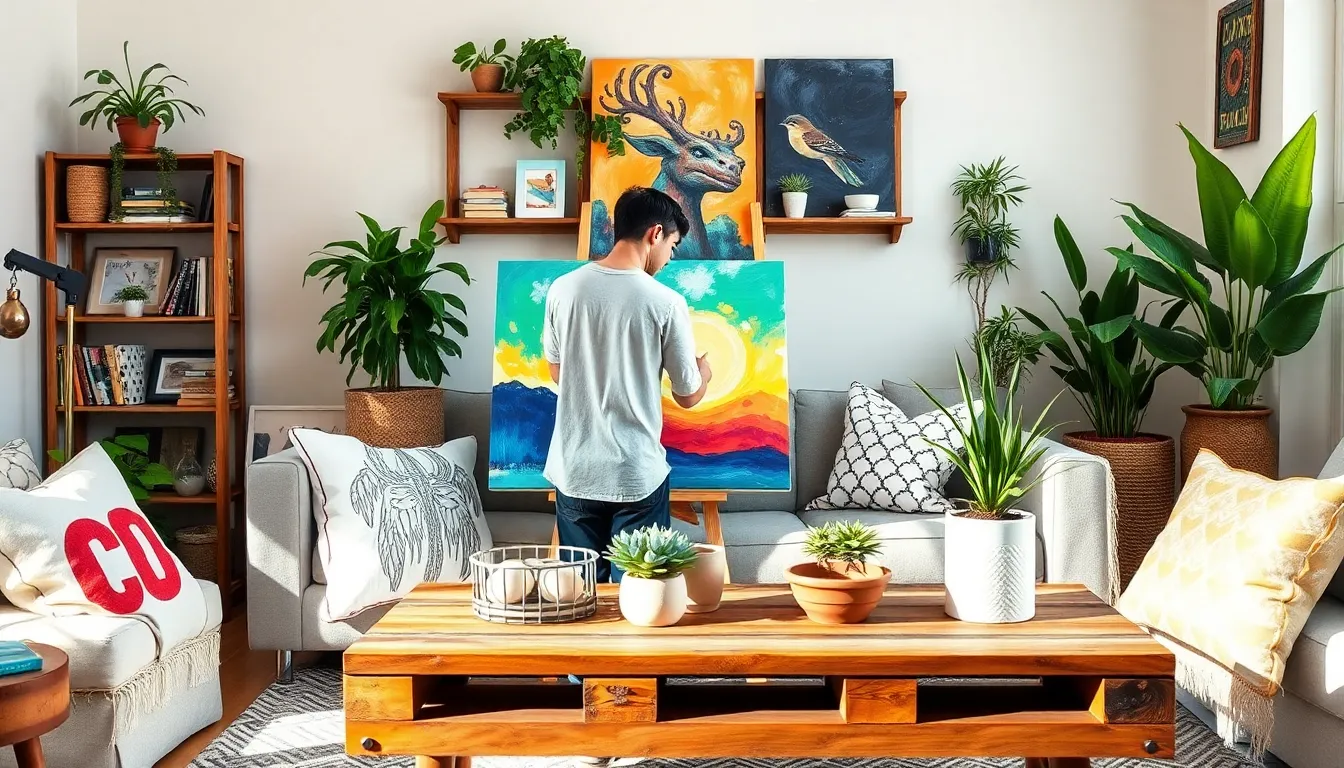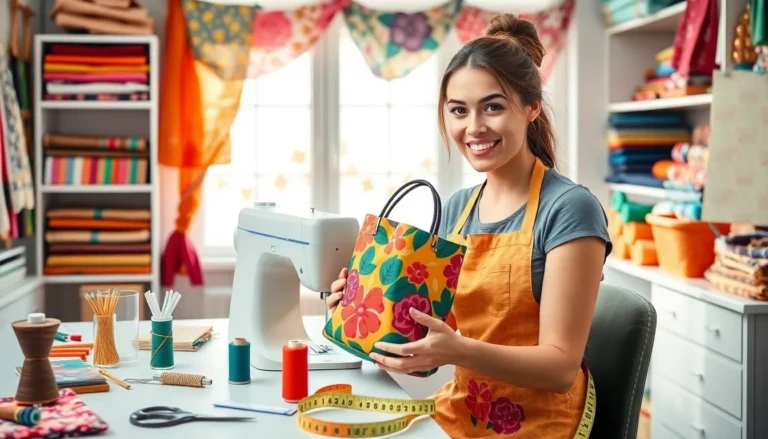Transforming a house into a home doesn’t have to cost a fortune or require a degree in architecture. With a little creativity and some elbow grease, anyone can tackle easy DIY home projects that breathe new life into their space. Whether it’s sprucing up a dull room or crafting unique decor, these projects are perfect for those who want to impress guests or just enjoy a little personal flair.
Benefits Of Easy DIY Home Projects
Easy DIY home projects offer numerous advantages that enhance both living spaces and personal satisfaction. Engaging in these projects often leads to tangible benefits, particularly in cost savings and personalization.
Cost Savings
Cost savings rank high among the benefits of easy DIY home projects. Homeowners avoid expensive labor costs by tackling tasks themselves. Simple repairs, fresh paint, or furniture refurbishing can reduce total renovation expenses significantly. For example, painting a room might cost around $300 if hired out, whereas DIY can drop that to $50 for supplies. Even small projects contribute to overall savings, allowing individuals to allocate funds to other home improvements or personal interests.
Personalization
Personalization stands out when discussing easy DIY home projects. Each project enables individuals to express their unique style and preferences. Customizing décor items or furniture not only enhances aesthetic appeal but also makes a space feel genuinely theirs. Adding personalized touches like built-in shelves or unique wall art can highlight personal interests and memories. For instance, creating a gallery wall with family photos provides a distinctive character that store-bought items rarely match. Tailoring spaces through DIY projects fosters a deeper connection between individuals and their homes.
Popular Easy DIY Home Projects

Easy DIY home projects enhance any living space with creativity and personal touch. Various options exist to suit different tastes and needs.
Home Decor Ideas
Beautiful wall art transforms empty spaces into focal points. Canvas prints or painted tiles provide affordable options for customization. DIY shelves can display decor items and books, maximizing wall space while adding character. Using reclaimed wood for projects contributes to sustainability and unique aesthetics. Personalized throw pillows also bring comfort and style, using fabric paint or stencils to create custom designs. Indoor plants can be arranged in creatively designed pots, enhancing both air quality and decor.
Functional Furniture
Functional furniture can save space and add utility. A coffee table with hidden storage keeps living areas organized while maintaining aesthetic appeal. Pallet furniture projects create rustic charm while being cost-effective and easy to assemble. Bench seating with built-in storage is perfect for entryways, combining practicality with style. DIY foldable desks provide flexible options for small spaces, adapting to various needs. Outdoor seating can also be crafted with simple materials, turning patios into inviting areas for relaxation and entertaining.
Tools And Materials For DIY Projects
Selecting the right tools and materials is crucial for successful DIY home projects. These items enhance efficiency and ensure high-quality results.
Essential Tools
Basic tools are necessary for most DIY tasks. A measuring tape enables accurate dimensions. Screwdrivers and a drill assist in assembling furniture. Pliers help grip small objects, while a utility knife is essential for cutting various materials. A level ensures shelves are straight. Clamps hold pieces securely together during assembly. Lastly, a safety kit—including goggles and gloves—promotes safety, protecting from potential injuries.
Recommended Materials
Using suitable materials enhances the quality and durability of projects. Plywood and MDF are ideal for creating furniture and shelves. Reclaimed wood adds rustic charm, creating unique aesthetics. Paint and wood stain allow for customization and personalization. Fabric comes in various patterns, perfect for throw pillows or upholstery projects. Adhesives, such as wood glue and spray adhesive, bond materials securely. Finally, hardware like screws and brackets supports structural integrity, ensuring long-lasting results.
Step-By-Step Guide To A Simple Project
Starting a DIY project requires careful preparation and execution. By following a structured approach, anyone can successfully transform their living space.
Preparing Your Space
Clear any furniture or items from the work area. This step minimizes disruptions and ensures safety during the project. Assess the available space and ensure proper lighting for visibility. Gathering tools and materials before starting keeps the workflow consistent. Consider using a drop cloth to protect floors and avoid damage. Safety gear, such as gloves and goggles, should also be handy for protection while working. Organizing the workspace enhances efficiency and allows for a smoother project execution.
Execution Tips
Begin by measuring materials accurately to prevent errors. Easy adjustments can resolve minor discrepancies during the build. Using proper techniques for cutting and assembling helps maintain quality. Seek help when lifting heavier items to avoid injury. Consistency in applying finishes, like paint, improves overall aesthetics. Checking progress regularly ensures alignment with the intended outcome. Finally, clean up the area once the project is completed to appreciate the new addition to the home.
Safety Tips For DIY Projects
Safety is a priority when tackling DIY projects. Proper measures ensure a successful and enjoyable experience.
Personal Protective Equipment
Wearing personal protective equipment (PPE) is essential. Safety goggles protect the eyes from dust and debris, while gloves guard the hands against cuts and splinters. A dust mask safeguards against inhaling harmful materials or particles. Hearing protection is necessary when using loud tools, such as saws or drills. In particular cases, wearing a hard hat may be advisable for overhead work. Ensure that all PPE fits comfortably to encourage consistent use.
Handling Tools Safely
Handling tools with care prevents accidents. First, always read the user manuals before operating any tool. Keeping hands dry and free from distractions while working improves control. Using tools for their intended purposes contributes to effective results and safety. When using power tools, maintaining a firm grip supports stability and precision. Never bypass safety features or guards on tools, as they provide crucial protection. Clear the workspace to avoid tripping hazards and allow easy access to needed materials. Always unplug tools when making adjustments or changing bits for added safety.
Easy DIY home projects are a fantastic way to bring creativity and personalization into any living space. By taking on these projects, individuals not only save money but also create environments that truly reflect their style and preferences. With the right tools and materials at hand, anyone can embark on a rewarding journey of home improvement.
Safety should always be a priority during these endeavors. Utilizing personal protective equipment and following safety guidelines ensures a smooth and enjoyable experience. Ultimately, engaging in DIY projects fosters a deeper connection to one’s home, transforming it into a cherished sanctuary filled with unique touches and memories. Embrace the DIY spirit and watch as your living space transforms into a true reflection of who you are.






